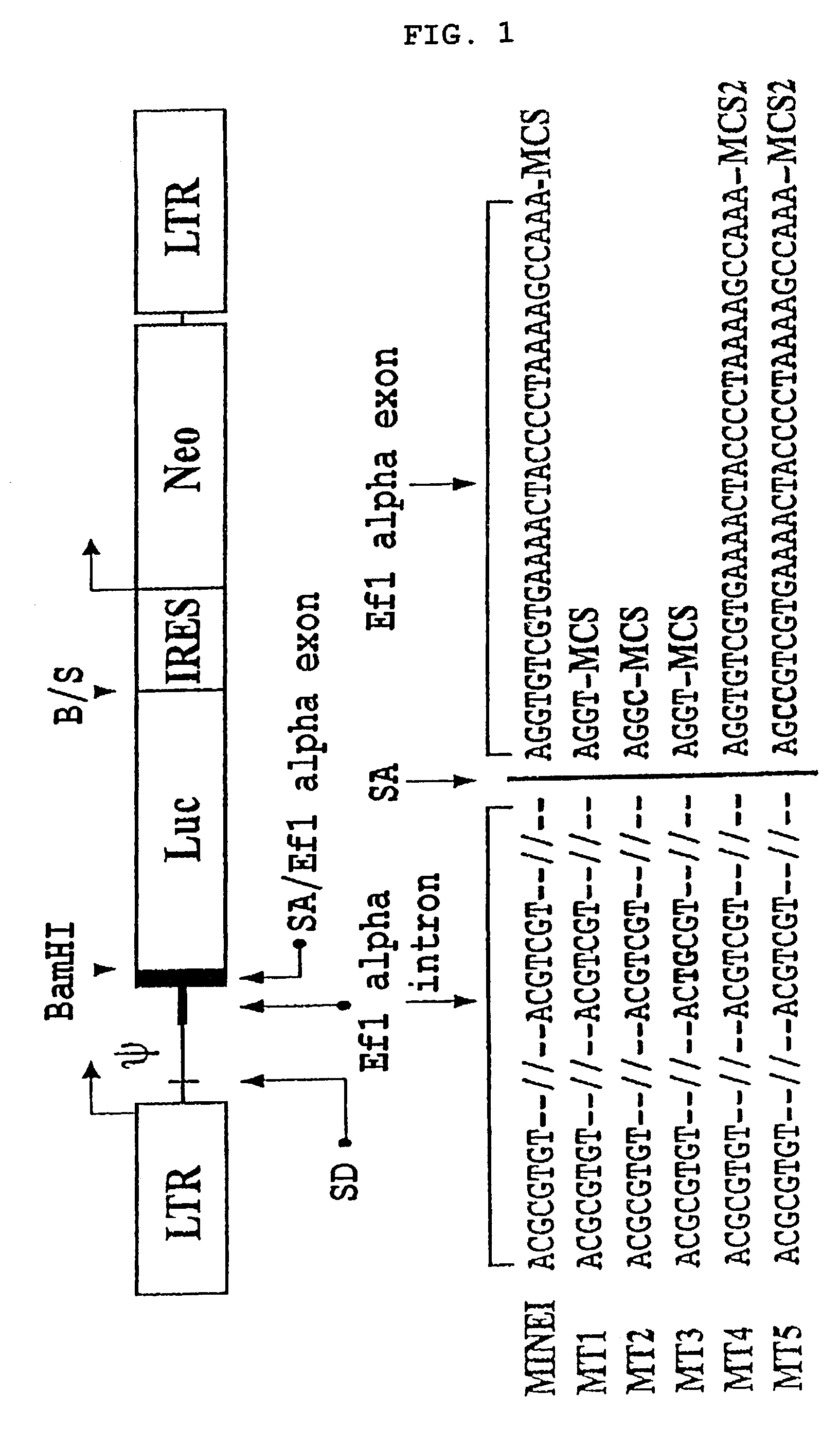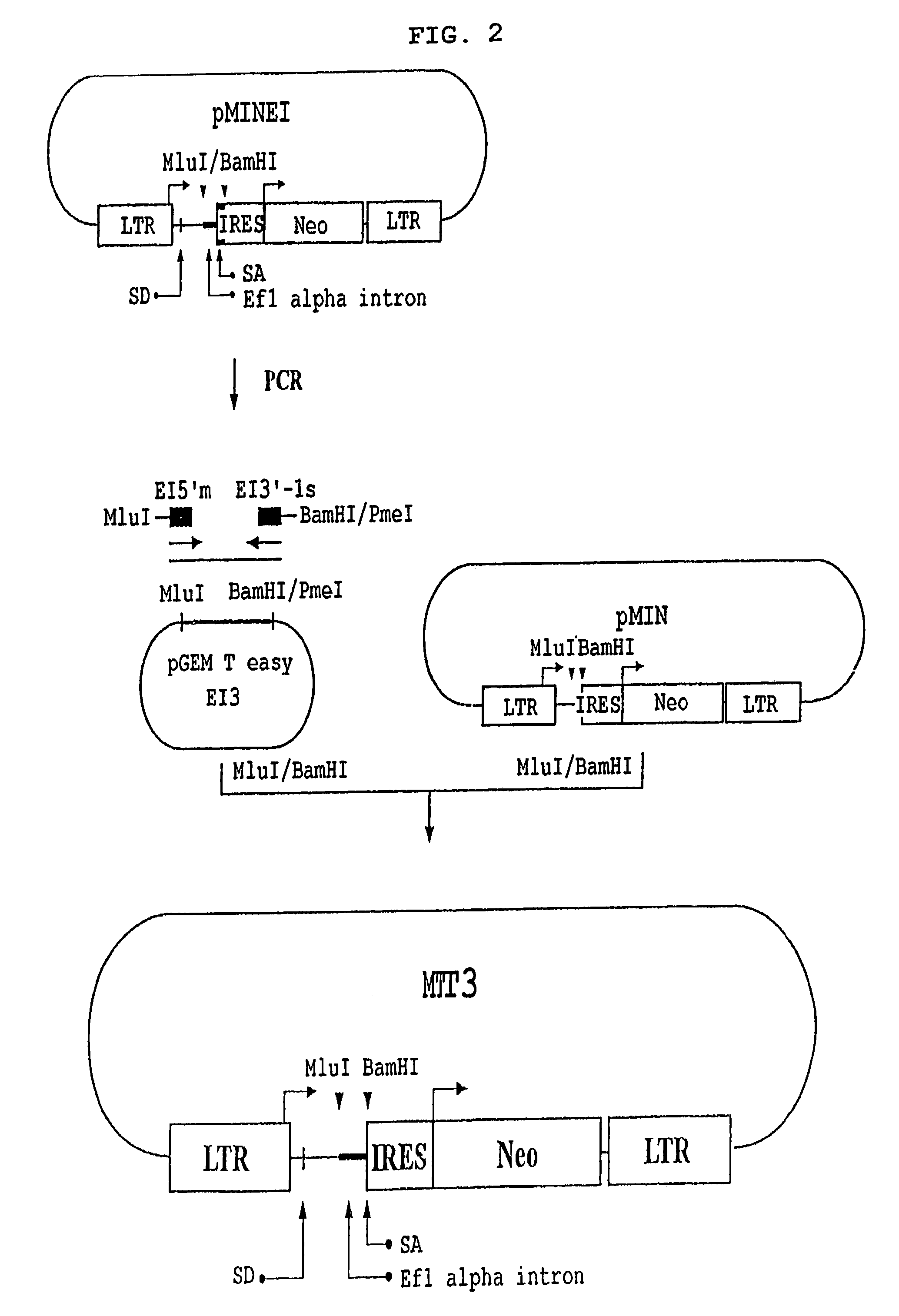High efficiency retroviral vector which contains genetically engineered cellular non-coding sequence harboring splicing acceptor
a gene therapy and high-efficiency technology, applied in the direction of viruses/bacteriophages, microorganisms, genetic material ingredients, etc., can solve the problems of rcr production risk, gene expression level not high enough to give clear therapeutic effects, and impede the wider use of these vectors, so as to achieve safe and highly efficient, the effect of avoiding rcr production
- Summary
- Abstract
- Description
- Claims
- Application Information
AI Technical Summary
Benefits of technology
Problems solved by technology
Method used
Image
Examples
example 1
Efficiency of Vector MIN-EI in Various Packaging Cell Lines
[0061]In order to investigate the efficiency of vector MIN-EI, containing the intron and non-coding sequence of the EF1α gene in various packaging cell lines, the gene expression level and viral titer was examined using commonly used packaging cell lines such as Phoenix (ATCC SD3443, Md., USA), FlyA13 (Cosset et al., J. Virol. 69: 7430–7436, 1995), and PG13 (ATCC CRL10686, Md., USA) cell lines.
[0062]MIN-CAT and MFG-CAT (Byun et al., Gene Ther. 3: 780–788, 1996) were employed as controls. MIN-EI-CAT and MIN-CAT were constructed by inserting the BamHI fragment of the plasmid pCRII-CAT (KR Patent Application No. 1998-24478), containing CAT (chloroamphenicol acetyltransferase) gene, into the BamHI sites of vectors MIN-EI and MIN, respectively. Vector MFG-CAT was constructed by inserting the NcoI-BamHI fragment of pCRII-CAT into the NcoI-BamHI site of vector MFG (Byun et al., Gene Ther. 3: 780–788, 1996).
[0063]Phoenix and FlyA13 ...
example 2
Viral Productivity of MIN-EI
[0071]To examine the reason why viral titer varies in accordance with the packaging cell line used, northern blotting analyses were performed. First, cytoplasmic RNAs were extracted from Phoenix cells transfected with MFG and MIN-EI, respectively, and also from PG13 cells producing MFG and MIN-EI, respectively, using the Guanidine thiocyanate-cesium method as follows: Cells cultured in a 100 mm dish were washed twice with PBS and 3 ml of guanidine buffer solution was added thereafter. Upon becoming transparent, the mixture was homogenized using a syringe, poured into a polyaloma tube (Beckman) containing 2 μl of 5.7 M CsCl2, and centrifuged at 20° C., 29,000 rpm for 16 hours to obtain an RNA pellet. The RNA pellet was dissolved in 150 μl of distilled water containing DEPC, and subjected to ethanol precipitation to obtain 50 μl of RNA solution.
[0072]20 μg of RNA was mixed with 20 μl of formamide, 10 μl of 37% formaldehyde, and 10 μl of 10× MOPS. The mixtur...
example 3
Construction of Retroviral Vector Having Both a Mutation at the EF1α Intron and a Non-Coding Sequence
[0076]In order to develop an improved vector drive a high level of gene expression without compromising viral titer, the mutation was introduced to maintain delicate balance between splicing efficiency and viral titer. 5 mutant vectors were constructed by introducing a mutation into and around the intron and splicing acceptor of the EF1α gene of MIN-EI (see FIG. 1):
[0077]1) MT1 wherein no mutation is introduced at the splicing acceptor and the region corresponding to exon 2 of EF1α is deleted;
[0078]2) MT2 wherein a mutation is introduced downstream from the splicing acceptor and the region corresponding to exon 2 of EF1α is deleted;
[0079]3) MT3 wherein a mutation is introduced upstream from the splicing acceptor and the region corresponding to exon 2 of EF1α is removed;
[0080]4) MT4 is a wild-type having no mutation introduced at the splicing acceptor; and
[0081]5) MT5 wherein a mutati...
PUM
| Property | Measurement | Unit |
|---|---|---|
| Length | aaaaa | aaaaa |
| Length | aaaaa | aaaaa |
| Fraction | aaaaa | aaaaa |
Abstract
Description
Claims
Application Information
 Login to View More
Login to View More - R&D
- Intellectual Property
- Life Sciences
- Materials
- Tech Scout
- Unparalleled Data Quality
- Higher Quality Content
- 60% Fewer Hallucinations
Browse by: Latest US Patents, China's latest patents, Technical Efficacy Thesaurus, Application Domain, Technology Topic, Popular Technical Reports.
© 2025 PatSnap. All rights reserved.Legal|Privacy policy|Modern Slavery Act Transparency Statement|Sitemap|About US| Contact US: help@patsnap.com



